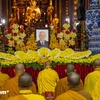The chair of the Council for Appraisal of Artifacts, Historical and Legal Evidence for Vietnam’s Sovereignty over Hoang Sa (Paracel) and Truong Sa (Spratly) has said that there is much legal evidence affirming Vietnam's sovereignty over the two archipelagos, the English-language news website VietNamNet Bridge.
Prof. Dr. of History Nguyen Quang Ngoc, one of the first members of the council, has long been completing the tasks of assessment, decoding artifacts, compiling historical and legal evidence and compiling them to serve as a basis for exhibitions on the archipelagos held by the Ministry of Information and Communications.
Ngoc said the first exhibition of this type was organised by Da Nang City named "Hoang Sa - Truong Sa Documents", mainly the documents about Hoang Sa. They are part of a research project by Dr. Tran Duc Anh Son and some overseas Vietnamese that includes a number of Western maps and Western atlases about China.
When the External Information Department of the Ministry of Information and Communications organised the national exhibition on Hoang Sa - Truong Sa, Ngoc was invited as the chair of the document evaluation council, which consisted of many experts from the Government Boundary Committee, the Ministry of Science and Technology, the Centre for Marine and Maritime Research, the Mapping Bureau, and others.
The council decided to choose historic Western maps collected by Dr. Tran Duc Anh Son, the Western Atlas about China that had recently been collected in the US, and some old maps and documents of Vietnam, particularly documents called “Chau Ban” (administrative documents of the royal court) as exhibits in the national exhibition on Vietnam’s sovereignty over Hoang Sa. The exhibition was a big success.
After each exhibition, the organisers received opinions and materials from the public to enrich their objects, documents and evidence for the next.
At the exhibition in Thai Nguyen, the organisers added photos of historic maps of the West, proving Vietnam’s sovereignty over Hoang Sa and Truong Sa. These are photos of the original maps, so the quality is very good, Ngoc said, adding these photos were taken by Son in France. Among them is a map by Taberd in 1838.
Ngoc said the amount of evidence, both historical and legal, of Vietnam’s sovereignty over Hoang Sa and Truong Sa, is huge. In terms of ancient maps alone, there are several hundred old maps of the West but the council chose only several dozen of the maps for exhibitions. There are also many valuable “chau ban”, particularly those of the Nguyen Dynasty (1802-1945).
He emphasised that the “chau ban”, including the reports of ministries and agencies to the emperor on sending flotillas to Hoang Sa to map and collect marine resources, are unique documents that only Vietnam has. These documents are highly praised for their legal value over Vietnam’s sovereignty over Hoang Sa and Truong Sa.-VNA
Prof. Dr. of History Nguyen Quang Ngoc, one of the first members of the council, has long been completing the tasks of assessment, decoding artifacts, compiling historical and legal evidence and compiling them to serve as a basis for exhibitions on the archipelagos held by the Ministry of Information and Communications.
Ngoc said the first exhibition of this type was organised by Da Nang City named "Hoang Sa - Truong Sa Documents", mainly the documents about Hoang Sa. They are part of a research project by Dr. Tran Duc Anh Son and some overseas Vietnamese that includes a number of Western maps and Western atlases about China.
When the External Information Department of the Ministry of Information and Communications organised the national exhibition on Hoang Sa - Truong Sa, Ngoc was invited as the chair of the document evaluation council, which consisted of many experts from the Government Boundary Committee, the Ministry of Science and Technology, the Centre for Marine and Maritime Research, the Mapping Bureau, and others.
The council decided to choose historic Western maps collected by Dr. Tran Duc Anh Son, the Western Atlas about China that had recently been collected in the US, and some old maps and documents of Vietnam, particularly documents called “Chau Ban” (administrative documents of the royal court) as exhibits in the national exhibition on Vietnam’s sovereignty over Hoang Sa. The exhibition was a big success.
After each exhibition, the organisers received opinions and materials from the public to enrich their objects, documents and evidence for the next.
At the exhibition in Thai Nguyen, the organisers added photos of historic maps of the West, proving Vietnam’s sovereignty over Hoang Sa and Truong Sa. These are photos of the original maps, so the quality is very good, Ngoc said, adding these photos were taken by Son in France. Among them is a map by Taberd in 1838.
Ngoc said the amount of evidence, both historical and legal, of Vietnam’s sovereignty over Hoang Sa and Truong Sa, is huge. In terms of ancient maps alone, there are several hundred old maps of the West but the council chose only several dozen of the maps for exhibitions. There are also many valuable “chau ban”, particularly those of the Nguyen Dynasty (1802-1945).
He emphasised that the “chau ban”, including the reports of ministries and agencies to the emperor on sending flotillas to Hoang Sa to map and collect marine resources, are unique documents that only Vietnam has. These documents are highly praised for their legal value over Vietnam’s sovereignty over Hoang Sa and Truong Sa.-VNA



















